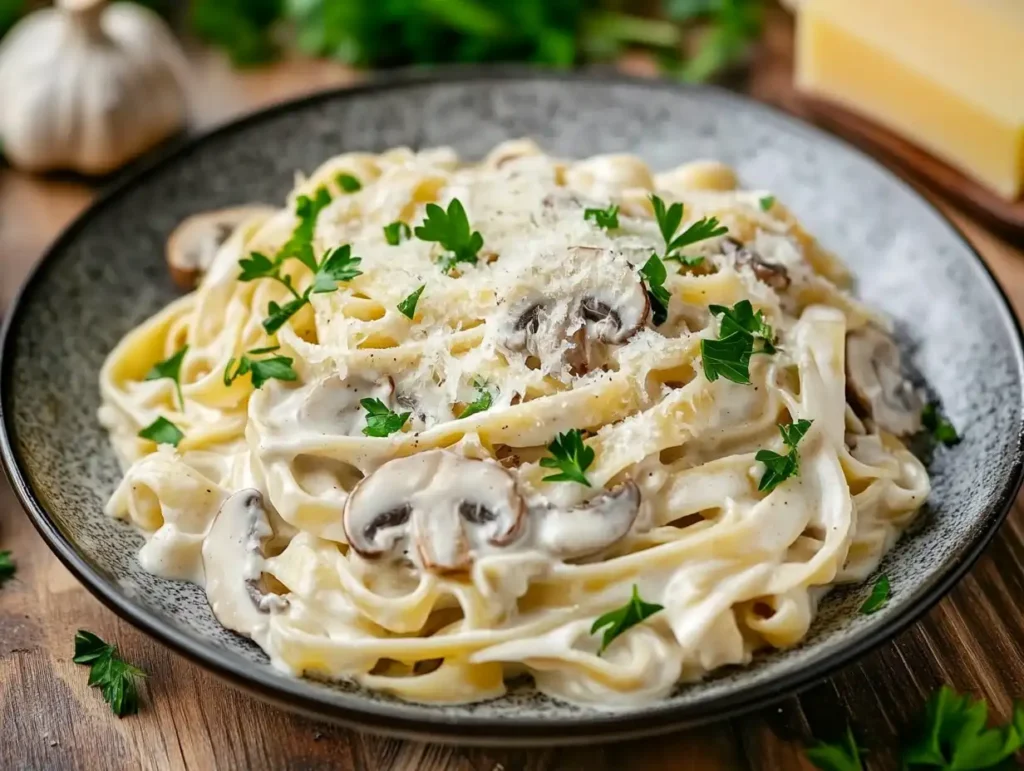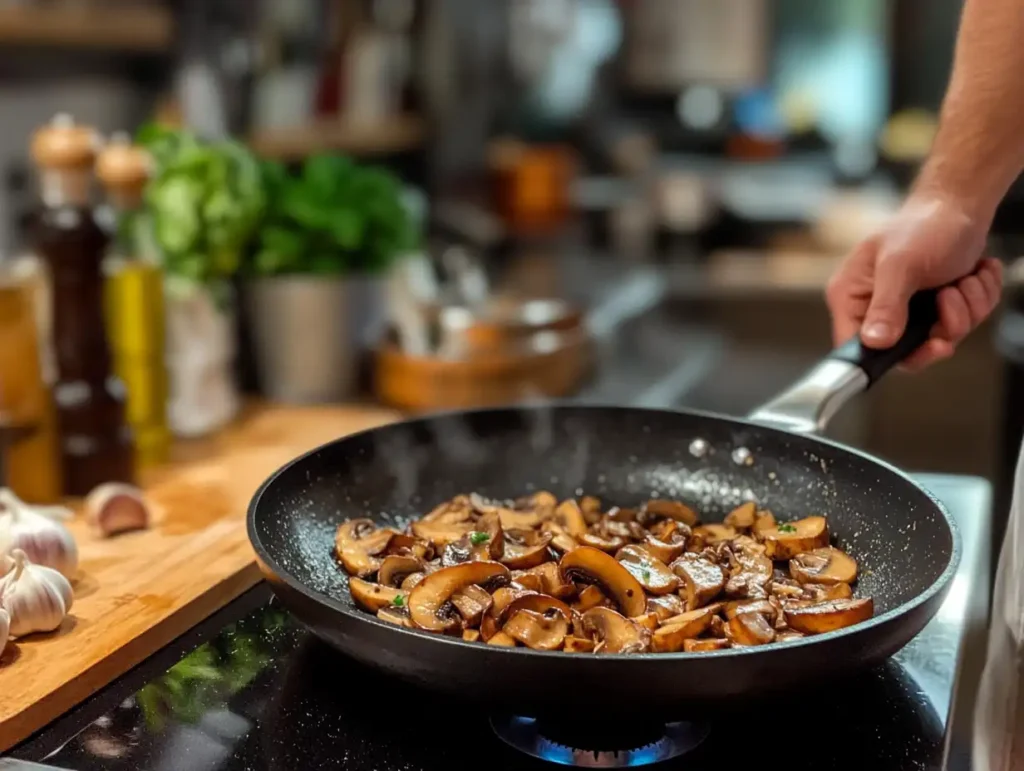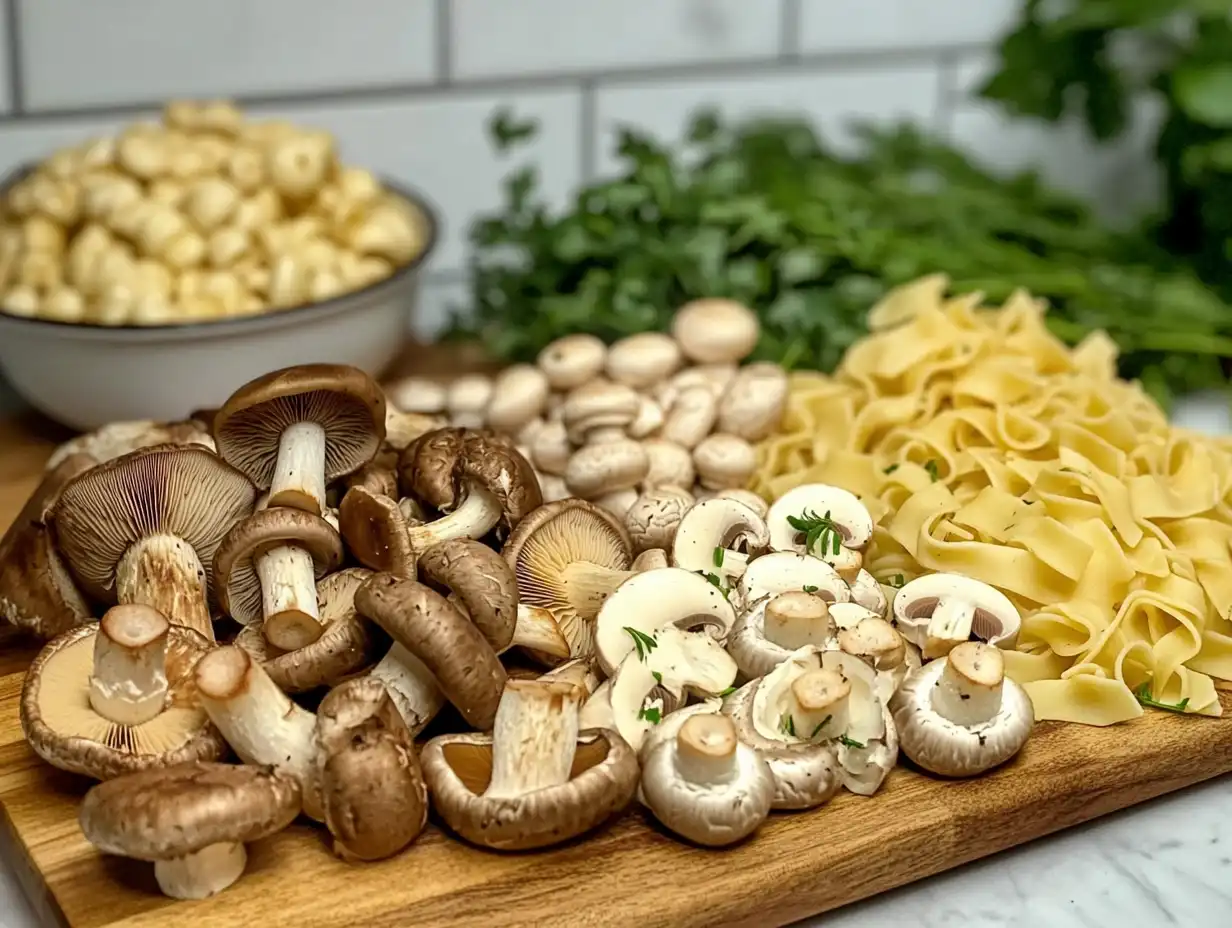Introduction
Mushrooms are a beloved addition to pasta dishes, but knowing what type of mushroom is best for pasta can take your meal from ordinary to extraordinary. Each variety brings unique flavors and textures, making it essential to choose the right one for your dish.
But with the incredible variety of mushrooms available ranging from button mushrooms to more exotic options like porcini or morels choosing the right type for your pasta dish can feel overwhelming. Each mushroom offers its own distinct flavor profile and texture, which can dramatically impact the overall taste of your dish.
In this comprehensive guide, we’ll explore the most popular types of mushrooms used in pasta, how to choose the best variety for your recipe, and the best ways to prepare them to create mouthwatering meals. By the end, you’ll have all the tools and tips needed to elevate your next pasta dish with the perfect mushroom.
Understanding Mushrooms
What Makes Mushrooms Unique?
Mushrooms are neither plants nor animals they’re fungi. What sets them apart is their umami-rich flavor, which provides a savory, almost meaty taste. This umami quality makes mushrooms an excellent choice for vegetarian and vegan dishes, where they often serve as a flavor-packed meat substitute. Their spongy texture also allows them to absorb and complement the flavors of the other ingredients in a dish.
Nutritional Benefits of Mushrooms
Mushrooms are not only delicious but also packed with nutrients. They’re low in calories and fat, making them a guilt-free addition to any pasta dish. They’re also rich in:
- B vitamins like riboflavin and niacin, which support energy production.
- Antioxidants that help combat free radicals.
- Minerals like selenium, copper, and potassium, which are essential for overall health.
- Dietary fiber, which aids digestion.
Their nutritional profile makes them a great choice for those looking to create healthy yet indulgent pasta dishes.
Popular Types of Mushrooms for Pasta
Choosing the right type of mushroom can make all the difference in a pasta dish. From mild and versatile options to rich and robust varieties, here are some of the most popular mushrooms that pair beautifully with pasta.
Button Mushrooms
Description: These are the most commonly found mushrooms and are often the first choice for many home cooks. Their mild flavor and firm texture make them a versatile addition to any pasta dish.
Best Used In: Button mushrooms work well in light tomato-based sauces, creamy pasta, or even as a topping for baked pasta dishes. They absorb flavors well and provide a subtle, earthy undertone.
Cremini Mushrooms
Description: Also known as baby bella mushrooms, creminis are a slightly more mature version of button mushrooms. They have a deeper, earthier flavor and a firmer texture.
Best Used In: These mushrooms shine in hearty pasta dishes, such as creamy Alfredo or garlic butter sauces. They’re also great for stuffing or roasting alongside your pasta.
Shiitake Mushrooms
Description: Shiitake mushrooms are known for their distinct smoky and woody flavor. They have a chewy texture that holds up well in cooked dishes.
Best Used In: Use shiitake mushrooms in Asian-inspired pasta dishes, creamy sauces, or as part of a savory mushroom ragu. Their bold flavor pairs well with rich and umami-packed sauces.
Portobello Mushrooms
Description: These large, mature mushrooms are meaty and robust, making them a popular choice for vegetarian recipes. Their rich umami flavor and dense texture mimic the qualities of meat.
Best Used In: Portobello mushrooms are perfect for pasta dishes with heavier sauces, such as Bolognese or mushroom stroganoff. They can also be sliced and grilled for a smoky addition to your dish.
Porcini Mushrooms
Description: A favorite in Italian cooking, porcini mushrooms have a nutty and slightly sweet flavor. They are often sold dried and need to be rehydrated before use.
Best Used In: These mushrooms are excellent in risotto-style pasta dishes, creamy sauces, or any recipe where you want to add depth and a rich, umami flavor. The soaking liquid from dried porcini can also be used as a broth to enhance the dish.
Oyster Mushrooms
Description: With their delicate, fan-shaped caps, oyster mushrooms offer a mild and slightly sweet flavor. Their texture is tender and works well in delicate dishes.
Best Used In: Oyster mushrooms are best in simple preparations, like garlic and olive oil-based sauces, where their delicate flavor can shine. They’re also great in stir-fried pasta dishes.
Morel Mushrooms
Description: Morels are a prized mushroom with a nutty, earthy flavor and a unique honeycomb-like appearance. They’re considered a delicacy due to their limited growing season.
Best Used In: Pair morels with creamy pasta sauces or use them in butter-based dishes to highlight their distinct taste. Their rich flavor works well in gourmet pasta recipes.
Flavor Profiles of Mushrooms
For creamy sauces, shiitake and porcini mushrooms are excellent options when considering what type of mushroom is best for pasta. Their rich, umami-packed flavors complement the velvety texture of cream-based sauces. Meanwhile, tomato-based dishes pair well with mild mushrooms like cremini or button. Wondering what type of mushroom is best for pasta to add gourmet flair? Porcini and morels are often the top choices for their deep, earthy flavors.
Mild Flavors
Button Mushrooms
Button mushrooms have a neutral and light flavor, making them a versatile choice for many pasta dishes. They easily absorb the flavors of sauces and seasonings, serving as a subtle base ingredient that complements other bolder elements in the dish.
Oyster Mushrooms
Oyster mushrooms are similarly mild but carry a hint of sweetness. Their delicate flavor pairs well with simple, herbaceous sauces like garlic and olive oil or lemon-based dressings.
Earthy and Umami Flavors
Cremini Mushrooms
Cremini mushrooms bring a deeper earthiness compared to button mushrooms. They are ideal for dishes that require a slightly richer and more pronounced mushroom flavor, such as creamy pasta or soups.
Shiitake Mushrooms
Shiitakes are packed with umami, often described as smoky and woodsy. Their bold flavor enhances dishes with creamy sauces or adds depth to tomato-based pasta recipes.
Portobello Mushrooms
With a robust umami flavor and a dense texture, portobellos are among the most “meaty” mushrooms. Their richness complements hearty sauces like Bolognese or Alfredo, making them a favorite for vegetarian alternatives.
Nutty and Rich Flavors
Porcini Mushrooms
Porcinis are renowned for their nutty, earthy taste, with hints of sweetness. These mushrooms shine in dishes where their bold flavor can take center stage, such as risotto-style pasta or pasta with truffle oil.
Morel Mushrooms
Morels offer a complex nutty flavor with earthy undertones. Their distinct taste is best showcased in dishes with butter or cream-based sauces, which highlight their natural richness.
Matching Flavors to Pasta Dishes
Choosing mushrooms with the right flavor profile ensures your pasta dish achieves the desired balance. For example:
- Mild mushrooms like button or oyster work well in light, fresh pasta dishes.
- Earthy mushrooms like cremini and shiitake are ideal for comfort foods with creamy or tomato sauces.
- Nutty mushrooms like porcini or morels shine in gourmet recipes where their distinct flavor can stand out.
How to Choose the Right Mushroom for Pasta
Selecting the right mushroom for your pasta dish depends on a variety of factors, including the flavor profile you desire, the type of sauce you’re using, and the overall complexity of the recipe. Here are some practical tips to help you choose the perfect mushroom for your next pasta creation.
Matching Mushroom Flavors with Sauces
The key to a harmonious pasta dish is pairing the mushroom’s flavor with the sauce.
- Cream-based sauces: Rich and velvety cream sauces benefit from bold mushrooms like shiitake, porcini, or portobello, which add depth and prevent the dish from feeling overly heavy.
- Tomato-based sauces: Earthy mushrooms such as cremini and button work beautifully in acidic tomato sauces, balancing the tanginess with their mild, savory flavors.
- Oil and herb-based sauces: Delicate mushrooms like oyster and button are ideal for lighter sauces with olive oil, garlic, and fresh herbs, allowing their subtle sweetness to shine through.
Tips for Fresh vs. Dried Mushrooms
Both fresh and dried mushrooms have their own benefits, and choosing between them depends on your recipe and availability.
- Fresh mushrooms: These are best for dishes where the texture is important, such as sautéed mushrooms served as a topping or mixed directly into the pasta.
- Dried mushrooms: Perfect for creating intensely flavored broths or sauces. Dried porcini, for instance, can be soaked in water, and the liquid can be incorporated into the dish for a robust, earthy taste.
When to Mix Different Types of Mushrooms
Combining multiple varieties of mushrooms in one dish can elevate its complexity and flavor. For example:
- Mix shiitake and oyster mushrooms for a balance of bold and delicate flavors.
- Combine porcini and button mushrooms for a layered umami experience in cream-based pastas.
- Use a blend of cremini, portobello, and shiitake mushrooms in hearty recipes like mushroom ragu for a multifaceted taste.
By carefully selecting and pairing your mushrooms with the other components of your dish, you can create a pasta masterpiece tailored to your preferences.
Best Pasta Recipes by Mushroom Type
Different mushrooms lend themselves to distinct pasta recipes, allowing their unique flavors and textures to shine. Below are some delicious ideas tailored to specific types of mushrooms, designed to inspire your next culinary creation.

Creamy Pasta with Shiitake Mushrooms
Recipe Overview:
Shiitake mushrooms are the star in this indulgent creamy pasta dish. Their smoky, umami flavor blends perfectly with a rich, velvety Alfredo sauce. Tossed with fettuccine or pappardelle, this dish is a comforting yet sophisticated option.
Key Ingredients: Shiitake mushrooms, heavy cream, garlic, Parmesan cheese, butter, fresh parsley.
Cooking Tip: Sauté the mushrooms in butter until golden and fragrant before adding the cream for enhanced depth of flavor.
Garlic Butter Pasta with Oyster Mushrooms
Recipe Overview:
Oyster mushrooms, with their delicate sweetness, shine in this simple and elegant recipe. A garlic butter sauce coats the pasta, highlighting the mushrooms’ tender texture and mild taste. This dish works best with linguine or spaghetti.
Key Ingredients: Oyster mushrooms, garlic, butter, olive oil, lemon juice, Parmesan cheese, fresh thyme.
Cooking Tip: Avoid overcooking oyster mushrooms, as they can become soggy. A quick sauté over high heat ensures they remain tender and flavorful.
Porcini Mushroom Risotto-Style Pasta
Recipe Overview:
Inspired by the creamy texture of risotto, this pasta dish uses the robust flavors of porcini mushrooms. Dried porcini are rehydrated, and their soaking liquid is used to create a rich, umami-packed sauce that clings beautifully to short pasta like orzo or farfalle.
Key Ingredients: Dried porcini mushrooms, white wine, garlic, chicken or vegetable stock, cream, Parmesan cheese.
Cooking Tip: Reserve the porcini soaking liquid, strain it to remove grit, and incorporate it into the sauce for a flavor boost.
Vegan Pasta with Mixed Mushrooms
Recipe Overview:
For plant-based pasta lovers, a mix of mushrooms such as cremini, button, and shiitake create a hearty, flavorful dish without the need for cream or cheese. A combination of olive oil, garlic, and fresh herbs brings out the mushrooms’ natural umami.
Key Ingredients: Mixed mushrooms, olive oil, garlic, shallots, fresh parsley, nutritional yeast, spaghetti or tagliatelle.
Cooking Tip: Use high heat to sauté the mushrooms, ensuring they caramelize and develop a deep, rich flavor.
Portobello Mushroom Stroganoff
Recipe Overview:
Portobello mushrooms are the highlight of this creamy stroganoff-inspired pasta dish. Their meaty texture and bold flavor stand up well to the tanginess of sour cream and mustard-based sauces, making this a hearty and satisfying meal.
Key Ingredients: Portobello mushrooms, sour cream, Dijon mustard, onion, egg noodles or wide pappardelle.
Cooking Tip: Slice portobello mushrooms into thick strips to mimic the texture of meat, enhancing the dish’s heartiness.
Cooking Tips for Mushroom Pasta
To make the most of mushrooms in your pasta dishes, it’s essential to understand how to handle, cook, and season them properly. These cooking tips will help you unlock the full potential of mushrooms, ensuring every bite is flavorful and satisfying.

How to Clean Mushrooms Properly
- Avoid soaking: Mushrooms act like sponges and can absorb water, which affects their texture and flavor. Instead, gently wipe them with a damp paper towel or use a soft brush to remove dirt.
- Rinse only when necessary: If mushrooms are especially dirty, rinse them briefly under cold water and pat them dry immediately with a clean cloth or paper towel.
- Trim stems: For varieties like shiitake and portobello, remove tough stems before cooking. These can be saved for broths or stocks to reduce waste.
Sautéing Techniques for Best Texture
- High heat is key: Cooking mushrooms on high heat allows them to caramelize, enhancing their natural flavors and preventing them from becoming soggy.
- Don’t overcrowd the pan: Mushrooms release moisture as they cook. Overcrowding the pan can cause them to steam rather than sauté, leading to a rubbery texture. Cook in batches if needed.
- Use the right fat: Butter adds richness, while olive oil provides a lighter option. For a mix of flavor, use a combination of both.
Enhancing Flavors with Seasonings
- Garlic and herbs: Garlic, thyme, parsley, and rosemary pair beautifully with most mushroom varieties, adding depth and aroma.
- Umami boosters: Soy sauce, miso paste, or nutritional yeast can amplify the savory notes of mushrooms in your pasta.
- Balancing acidity: A splash of white wine, lemon juice, or balsamic vinegar can brighten the dish and balance the earthiness of mushrooms.
Perfectly Incorporating Mushrooms into Pasta
- Combine mushrooms and sauce early: If using a sauce, add the mushrooms while it’s simmering to allow the flavors to meld together.
- Top for texture: For extra texture, reserve a portion of sautéed mushrooms to sprinkle on top of the pasta just before serving.
- Finish with cheese: Parmesan, Pecorino Romano, or even a touch of truffle-infused cheese complements mushroom pasta beautifully.
Mastering these techniques will ensure your mushroom pasta is not only delicious but also visually and texturally appealing.
FAQs About Mushrooms and Pasta
Are wild mushrooms safe to use in pasta?
Wild mushrooms can be an excellent addition to pasta dishes due to their intense and unique flavors. However, they should only be used if sourced from a trusted supplier or identified by an expert. Some wild mushrooms are toxic, so it’s crucial to ensure their safety before consumption.
Which mushroom is best for pasta?
Shiitake, porcini, or portobello are ideal for creamy sauces, while cremini and button mushrooms work well in tomato-based dishes. Porcini and morels are perfect for gourmet recipes.
What mushroom is best for sauce?
Porcini mushrooms create rich, umami-packed sauces, while shiitake adds smoky depth. Portobello works well in hearty sauces like stroganoff, and button mushrooms suit mild, everyday sauces.
What type of mushroom is used for cooking?
Button mushrooms are the most common, followed by cremini and shiitake for their flavor. Portobello is popular for grilling and stuffing, while porcini is prized for gourmet recipes.
What type of mushroom is popular?
Button mushrooms are the most popular globally, followed by portobello for their meaty texture, shiitake for umami flavor, and porcini for gourmet cooking. Cremini is a versatile favorite too.
Conclusion
Understanding what type of mushroom is best for pasta allows you to pair the right mushroom with your sauce, ensuring a balanced and flavorful dish. With the right selection, you can elevate your pasta to a new level of taste and satisfaction.
Mushrooms are a versatile and flavorful ingredient that can elevate any pasta dish. From the mild and adaptable button mushroom to the rich and nutty porcini, each variety brings its own unique qualities to the table. By understanding the flavor profiles of mushrooms and how to pair them with sauces, you can create dishes that are both delicious and balanced.
Whether you’re sautéing shiitake mushrooms for a creamy fettuccine or using porcini in a gourmet risotto-style pasta, the possibilities are endless. With the tips and insights shared in this guide, you’re ready to experiment and discover your favorite combinations. So, grab your favorite mushrooms, fire up the stove, and enjoy crafting mouthwatering pasta dishes that will impress your taste buds and guests alike.
